Disney animators faced the 1970s in a glum mood. After Walt Disney’s death in 1966, it seemed more than possible that the storied animation department would be closed down completely as the company moved on to focus on other, more profitable things such as family friendly live action films, theme parks, and merchandise. The Aristocats had earned back its costs, but not much more than that, and critics had noted—or claimed to have noted—the lack of the distinct Walt Disney touch. The animation studio’s budget was slashed. About all the animators really had on their side was company history, which virtually identified “Disney” with “animation.” To continue the success of the Disney brand, they argued, the animation studios needed to continue to produce full length films. Disney executives were not quite persuaded, but did release just enough—just barely enough—money to let the animators cobble together another full length film, Robin Hood.
Like many Disney projects, plans for this film had been tossed around for decades, starting in the early 1930s, when Walt Disney, looking for additional projects, came across the tale of Reynard the Fox. For Disney, Reynard’s tale had a couple of advantages: it featured a cute animal, a Disney strength. As a medieval tale, it was fully in the public domain, freeing Disney from needing to pay for the copyright. It also had one major disadvantage: in the original story, Reynard is a trickster and, worse, a thief. Disney had just managed to get away with a little lying wooden puppet in Pinocchio, and a Dog With a Past in Lady and the Tramp, but an outright thief as a protagonist was a line too far. The initial financial failure of Pinocchio (1940) which had featured a fox antagonist, was also discouraging. A virulently anti-Semitic version of the story in Dutch, printed in 1941, proved the final straw.
Walt Disney still liked the idea of a fox character, however, and art director Ken Anderson—who would eventually, much to his irritation, be given script and creative credit for Robin Hood—continued to produce various sketches of animal characters and suggestions for incorporating the fox character into various other films: as cartoon segments in the live action Treasure Island (1950); as the antagonist against Chanticleer, a rooster, based very loosely on Edmond Rostand’s Chantecler, a project that was eventually dropped in the 1960s; and a Western featuring talking animals.
This is more or less how animators arrived at the incoherency that would be Robin Hood: it was a mess of all of the above ideas, none of which were, in fact, Robin Hood. Robin Hood only entered the picture (forgive the pun) when Ken Anderson realized that calling the fox Robin Hood would allow the film to keep the fox as a trickster and a thief, like Reynald, while still being—mostly—a hero, like Robin Hood. A nod to that contradiction does appear early in the film, when Little John asks Robin Hood if they are good guys or bad guys. Robin says they are good guys, and then the subject is pretty much immediately dropped for hijinks, apparently never troubling Little John’s conscience again.
The decision to use the Robin Hood name did not mean that the animators had any interest in researching the Robin Hood legends to add elements of those to their trickster fox/rooster/Western film. Instead of checking literary sources like Sir Walter Scott’s 1820 Ivanhoe or Howard Pyle’s 1883 The Merry Adventures of Robin Hood, animators instead watched Robin Hood films, chiefly the 1938 classic The Adventures of Robin Hood, featuring Errol Flynn and Olivia de Havilland. That choice had some profound effects. First, The Adventures of Robin Hood bursts with color—showing off the Technicolor process was one purpose of the film—which in turn helped create the look of the Disney film, which keeps most of its characters in similarly bright colors. Most of the Disney backgrounds were based on the locations and sets Warner Bros built for their film: a positive, since Warner Bros deliberately designed those castle sets to allow for plenty of stunt work and movement, something Disney would take advantage of in some later scenes in the film. This also meant bringing in a character new to the literary Robin Hood sources: Disney’s Lady Cluck, directly based on WB’s Bess, a character created specifically for the great Una O’Connor (probably best known on this site for Bride of Frankenstein) in the earlier film.
And since the earlier film had not made the slightest pretense towards historical accuracy—or any sort of accuracy—that helped free the Disney film from any such pretense as well, allowing Disney to do such things as, say, keep the original sketches of the Sheriff of Nottingham walking around with a badge straight from the Wild West, a holdover from the earlier concept of the talking animal Western film.
At the same time, however, The Adventures of Robin Hood had been created in part to demonstrate that Warner Bros could make something other than cheap gangster films and to sneak in a highly anti-Nazi, pro-American intervention film right past censors who had strictly forbidden Hollywood studios to produce any such thing. Neither of these were huge concerns for Disney animators, so part of the fierce energy behind the earlier film was lost in this animal adaptation, replaced by elements from the previous conceptions of the fox character.
Speaking of which, I honestly don’t have a problem with the concept of an anthropomorphic Robin Hood, but some parts of the execution are, shall we say, a bit odd, starting with, what are North American raccoons doing in medieval England, and continuing with why, exactly, is Maid Marian, a fox in all senses of that word, the niece of two lions? Was she adopted? All of the other families and couples are grouped by species, so yes, this stands out. And why doesn’t Maid Marian—still a fox—eat Lady Kluck, a hen? Or the little rabbits that end up in her castle yard? Is it possible—barely possible—that she vanishes from most of the movie not because the animators had no idea what to do with her, but because she knows she has to eat a rabbit, now, and decides to indulge in that need far away from Nottingham?
(Look, I can’t be the only person who has thought this.)
The most distracting thing about the characters, however, is probably not that they’re animals, but that although about half of them sport proper British accents, one apparently arrived straight from Alabama, one is singer Phil Harris, and the others sound like they’re straight out of a Western—because, as it turns out, all of their voice actors were straight out of a Western, known specifically for those roles. This is hardly the only instance in a film filled with anachronisms and “uh, what is going on here,” but it’s one of the more distracting.
Also mildly distracting: the decision to start the film with pictures not of animals, but of a storybook filled with human knights and kings, before zooming into a rooster, Alan-A-Dale, who informs us that animals tell the Robin Hood story very differently. That’s the last of the humans, as the rooster starts to sing—later, this song would be attached to a hamster dance, but let’s try not to get too depressed in this post—introducing the characters and their voice actors, including a few celebrities, before trying to draw out the length of the picture by including little bits of animals chasing each other that—spoiler alert!—is taken straight from later scenes in the film, and by taken straight, I mean they’re the same animation cels.
It was a budget saving stunt the film would use again and again. Baloo from The Jungle Book and Little John in this film happened to be voiced by the same actor, Phil Harris, so animators simply reused the character design—and in some frames, reused the animation cels from the earlier film. Things got worse from there. If, while watching Maid Marian lift her skirts to dance in the forest to the sound of Phil Harris’ cheerful “The Phony King of England” you are suddenly struck by the resemblance to a similar dancing moment from Snow White, this would be because it is the similar dancing moment from Snow White: the animators simply traced the earlier animation. And if, in this same scene, you find yourself asking, wait a minute, isn’t that one of the cats from The Aristocats? Yes, yes, it is—in another reuse of the actual animation cels from a previous film.
When Robin Hood didn’t simply trace from previous Disney films, or reuse animation from previous Disney films, it cannibalized its own animation sequences, frequently and obviously reusing them. The crowd reaction scenes in the archery competition sequence are arguably the worst offenders, but Robin Hood also reused sequences with the church mice, the vultures, and flying arrows. In one case, to be fair, this creates a pretty decent visual joke, but mostly it results in a lot of visual, obvious repetition. The film also has a moment where Robin and Marian give each other a long, intense stare, allowing the camera to move in closer to each unmoving face—not at all incidentally allowing the animators to skip drawing several additional cels. A later scene with Prince John and Sir Hiss pulls the same trick.
As a final dismal note, all of this animation featured thick, rough, black lines, instead of the fine colored lines that Disney had created in earlier films and would start creating again in just two more films (with The Rescuers), an unavoidable consequence of the still unrefined xerography process. It’s not completely ugly, but it helped show the budget strains.
Also showing the strains: the plot, what there isn’t of it, since instead of a plot, the film went with various loosely connected bits: Robin Hood and Little John robbing the king, then a detour to meet a little bunny who is having a very very sad birthday until Robin Hood shows up, then another detour to meet Maid Marian and Lady Cluck, then the archery tournament, with the initial parts more or less lifted, except for the balloon, from the Errol Flynn film, then another detour with Maid Marian and Robin Hood, then a sad sad moment at the Nottingham jail and church (mostly to allow the animation to slow down and use fewer cels for several frames, in yet another cost cutting technique), before the final confrontation between Robin Hood and Prince John, which is only the final confrontation because after that, King Richard shows up, and, well, that’s it.
Sorta connecting this are the characters, including the little bunny who, as it turns out, wants to be an archer, and assorted other bunnies, and a turtle, and some poor church mice, some vultures under the impression that they are in a Western film, and of course Robin Hood, Baloo—er, that is, Little John—Friar Tuck, the Sheriff of Nottingham, and, singing along, Alan-A-Dale. Most are unmemorable, with two exceptions: the villains, Prince John (voiced by Peter Ustinov) and Sir Hiss.
Prince John is often regarded as the most inept of the Disney villains, in large part because his plan to capture Robin Hood at the archery tournament fails spectacularly, because his underlings openly mock him, and because he manages to set his own castle on fire. Not exactly strong evidence for competence, I admit. Oh, and he’s more than a bit sexist, with his insistence that women can’t be bandits. Granted, in this film, women aren’t bandits—these particular women are just Robin Hood and Little John in unconvincing disguises, but still, his reasoning is not exactly great here. And even his loyal and evil underling Sir Hiss objects to one of Prince John’s plans as being too evil.
But against this, Prince John also manages to succeed in most of his goals. He amasses sacks of gold and manages to throw nearly the entire population of Nottingham into jail—and not just briefly, either. His plan for drawing Robin Hood out does, indeed, draw Robin Hood out: if the rest of his minions had been even slightly more competent—and had Lady Kluck not flown to the other side—it might even have solved his Robin Hood problem. And he comes extremely close to killing Robin Hood, more than once: indeed, in one scene the characters are briefly convinced that Robin Hood is dead. And in the end, Robin Hood never does completely defeat Prince John. That’s King Richard.
No, Prince John isn’t so much inept as pathetic. And here is where—on top of the film’s other issues—I find myself cringing more than once. Because Prince John is laughed at, again and again, by the other characters, because he still cries for his mother and sucks his thumb, despite being a grown-up. Of sorts.
I cringe, partly because I can identify, closely. It took me awhile to break that particular habit—sucking my thumb. But partly because Prince John is getting mocked for being a child—much like his audience. He ends the film doing hard labor, presumably the first step in becoming a grown-up. It’s deserved: he has, after all, spent the entire film mostly lounging around while his minions busily dispossess the good people of Nottingham of their gold, and it’s no doubt about time that he put in some actual labor.
At the same time, however, I can’t help but feel, as the film goes on, that what I’m really watching is not so much the story of Robin Hood, stealing from the rich and giving to the poor, but rather the story of a little lion with very little self-esteem and deep set parental issues, who ends up getting bullied by nearly everyone except for his one friend, and after finally getting his vengeance, ends up in jail.
What I’m saying is, I don’t necessarily know who to cheer for here. I’m back to Little John’s question at the beginning of the film: Hey, Robin, are we the good guys, or the bad guys? That question is inherently part of most Robin Hood retellings, granted, since they are stories that cheer on a thief, but I think perhaps Walt Disney was on to something when he said that having a crook as a protagonist in an animated film for kids had issues.
Robin Hood can be, and has been, read as a metaphor for what was more or less going on at Disney at the time—the benevolent, wise, rightful ruler (Walt Disney) gone, replaced by various inept villains (the incoming executives) trying to choke every last cent out of the morose survivors (the animators) and ok, fine, I can see it that way. But although this may be an accurate metaphor, it’s not always a particularly entertaining one.
On a lighter note, Robin Hood has several cute visual jokes here and there—like having the royal trumpeters be trumpeting elephants, get it, ha ha? And the moment when Sir Hiss ends up floating away in a balloon, only to be shot down later. It’s not at all period, and I’d love to know how anyone at a medieval fair managed to find latex for a balloon, but maybe they used a pig’s bladder. Or maybe they got Little John, with his distinctive American accent and general feeling that he’s just attending a modern Renaissance fair, to pick up some balloons before he wandered into the film. However, since this is soon followed by an even greater anachronism as Lady Cluck and various rhinos start tackling each other to the strains of what sounds suspiciously like American football music (mostly to allow Robin Hood to sneak in yet another repeat of the same cheering crowd sequence) I suppose I shouldn’t complain. Plus, if we get too into this, we’ll also have to figure out where Robin Hood and a later band player picked up their sunglasses.
I’m also amused by the moment when the Sheriff of Nottingham saunters into a castle, singing Little John’s none too kindly song about Prince John, and getting Sir Hiss to join in—it’s a rather catchy tune, after all, so I’ll buy this. Even if this does result in crushing taxes on the animal population. All of that ended up being rather better than I remembered.
Robin Hood did decently in its initial box office release and a few later rereleases. The company still occasionally releases Robin Hood trading pins and fine art from time to time, and Disney caricature artists will draw you as a fox character if you ask. (That may not actually be related to Robin Hood, but I thought it was important to note.) Otherwise, the film fell into obscurity, remembered, when it’s remembered at all, as either one of the weaker Disney films or the film that helped to bring us that hamster dance moment, however incidentally.
But for all its flaws, Robin Hood had two major effects on the history of animation. First, this was the film that brought Don Bluth, who would later create his own animation studio, back to Disney and trained him in character animation. And second, its box office take was enough to prevent Disney executives from shutting down the animation department—though for the next several years, Disney would focus on adaptations of literary sources instead of original films.
Next up: Fantasia 2000.
Mari Ness lives in central Florida.










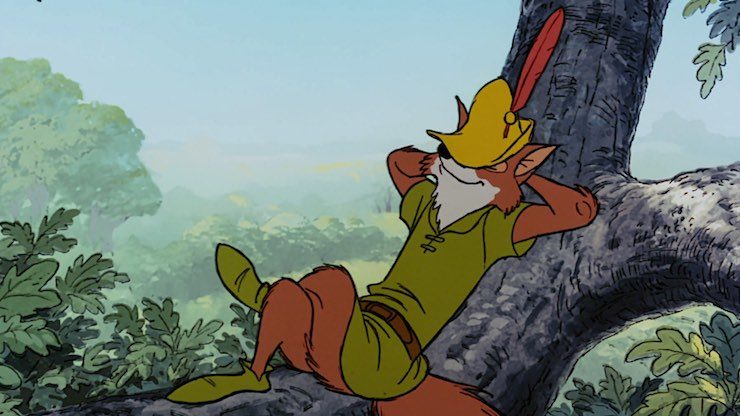
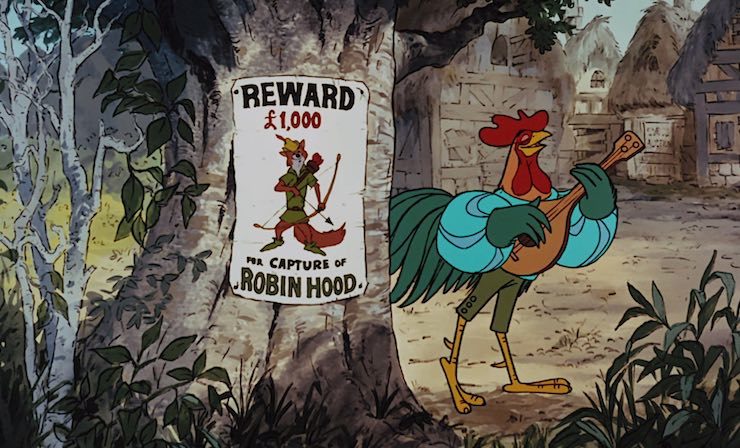
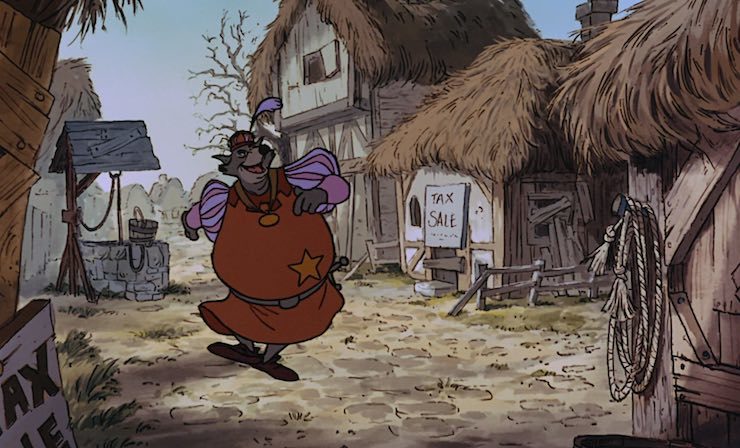
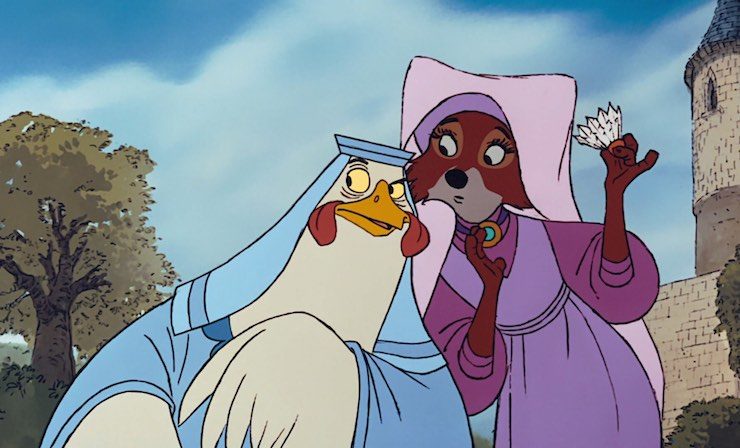
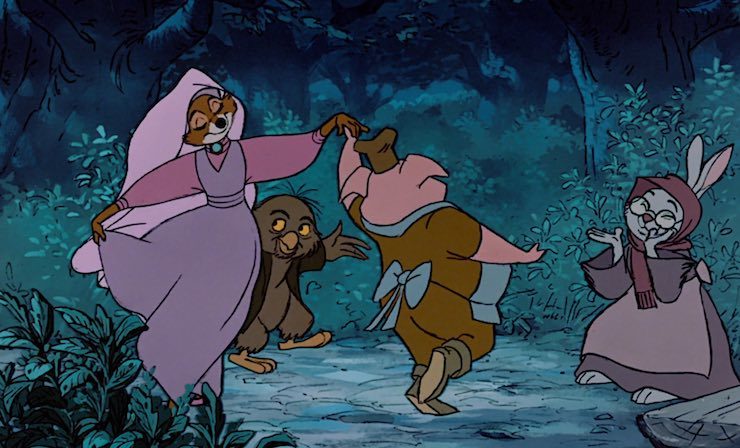
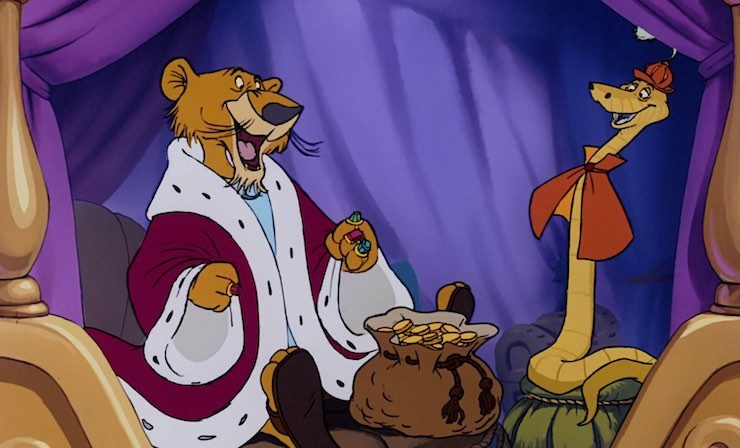
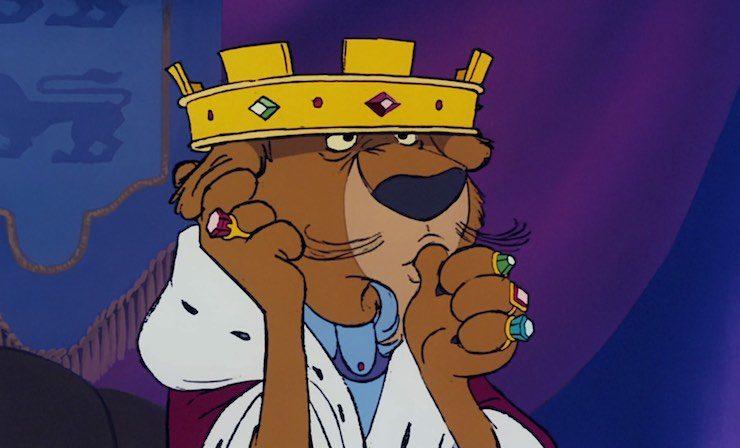
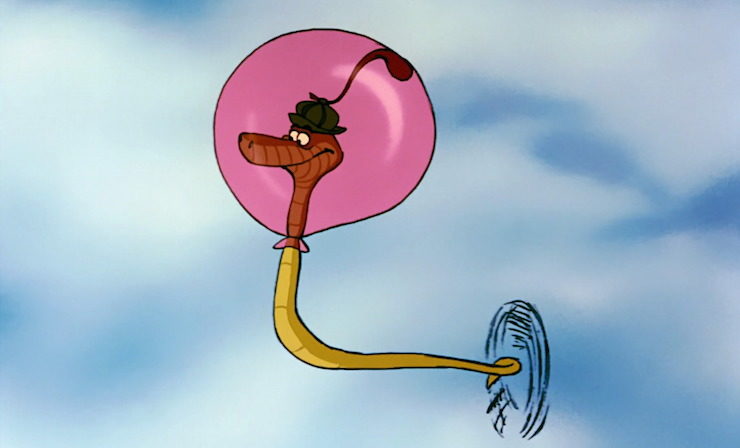
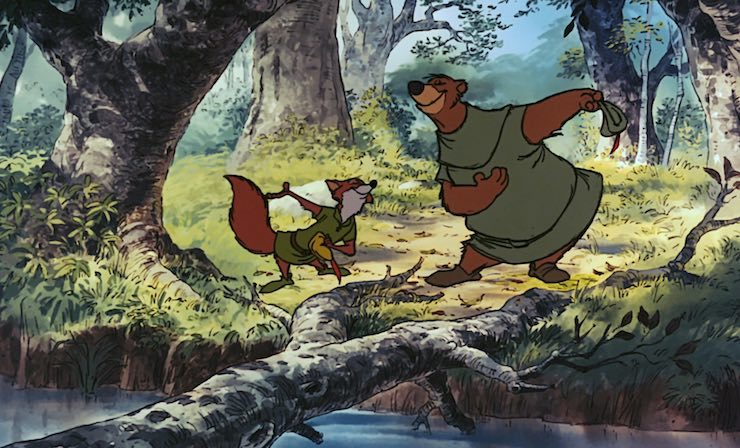
Myself and many of my coworkers of my generation grew up with the 70’s Disney movies and have very fond memories. Jungle Book, Aristocats, Robin Hood, Rescuers, Fox and Hound. These are the ones that we remember and love the most.
Robin Hood is a lot of fun, but is also sprinkled in with some depression and misery like all the 70’s Disney. But that just makes the eventual triumph that much better. And the songs are the best. That movie is filled start to finish with great music. The only sub-par song of the whole bunch is the love song.
Best Disney movie? Probably not. Favorite Disney movie? You betcha. Mostly forgotten? Not by a long-shot.
I remember this one very well. It’s one of the ones my dad ripped onto dodgy tapes for us way, way back.
As far as plot goes – it’s mostly hijinks, connected together by all featuring the same set of antagonists and taking place close to the same time. Which makes sense when the characters aren’t in it to be heroes, they just want to get by one day at a time (and rob people, but apparently Robin Hood and Little John aren’t too attached to that way of life.)
When it comes to the animals and accuracy, the part that bothers me isn’t that they don’t eat each other, it’s that Lady Cluck can use her feathers as fingers.
Obscurity? Everyone I know grew up watching this film on VHS. Looking it up online, upon its initial release, it was also Disney’s most successful to date, which is a little better than doing “decently.” Not sure where all the negativity is coming from.
I’ve never found the mixing of Old England and Old West all that strange. I mean it seemed to me these Disney characters were like a diverse animated acting troupe putting on a show, and this show happened to be Robin Hood. At least that’s how it works in my mind.
You mentioned Bride of Frankenstein. That’s another film set in a sort of nebulous movie land—in this case old Eastern Europe with various characters and accents, several of which are definitely not Eastern European.
I was born in the 80’s and almost all the kids I grew up with watched Robin Hood on tape repeatedly. If you didn’t want to BE Robin, then you wanted to marry him. Maybe both?
Mari, I love your reviews and this whole series. I’ll admit that every criticism you make is valid here. I am also the kind of person who typically applies logic to animated fantasy worlds. But I adore this movie with my whole heart. I put this movie on in the background when I grade papers. My roommates and I would put it on in college when we just wanted to chill. We would quote it constantly. I once asked a girl out in college because she was humming “Not in Nottingham.” Even though my wife is not a fan she still tells our son to “Close your sleepy little eye-bowls.” when he needs a nap. It is comfort food and its colors and rhythms are warm and pleasant and homey for me. Last week I put some art from it as the background on my phone because it just makes me smile when I see it. The voice acting is in no way consistent in terms of accent, but I find every single performance unbelievably charming.
It is by far, and absolutely based on blinding nostalgia, my favorite Disney animated film.
I loved this movie as a kid, and there definitely was a point where I was all, ‘wait a sec…why do some of these characters have southern accents??’…the mishmash of the different sources is interesting to know. I agree that upon rewatch the plot drags in a few parts but overall I think it hangs together, and the little bunnies are adorable. I always really liked the O-de-lally song too :)
I am pretty sure the football music is On Wisconsin. Which is especially funny to me now that I live in Wisconsin and the Badgers are a big deal here. (I hate football).
@6 – ” I once asked a girl out in college because she was humming “Not in Nottingham.”” – hahaha, that is a great story. Did she say yes?
When I grew up watching this, I didn’t notice any of the things you pointed. Ahh, the beauty of being a child.
Chiming in as someone who loved this movie as a kid in the 80s, too. We must have had the soundtrack, because I can still remember all the songs, even without having heard them for years. As soon as I read @1’s reference to the love song, it immediately popped into my head, even though it’s not nearly as memorable as “Not in Nottingham”
@7: Now that I think of it, I think you’re right! And all my life I didn’t know, because no one in the family cares that much about college football.
I too loved this film as a kid in the eighties.
Even as a child though I was confused by all the weird foreign accents in mediaeval England. As a teenager I began to deeply resent it for its portrayal of the Sheriff of Nottingham as if he were some sort of small-town sheriff rather than one of the most powerful men in northern England – a lot of my American friends at university said they found it confusing how a small town sheriff could in Prince of Thieves think he had a chance of seizing the crown, and I think they’d have appreciated the difference in meaning more if Disney hadn’t confused them as children. It would have been unlikely, but not totally unthinkable (see the period known as the Anarchy for powerful magnates trying to carve out kingdoms for themselves during a time when the Crown was severely weakened).
As an adult I just wonder which Robin Hood would have won in a fight – Disney’s Robin or Cary Elwes.
I loved this movie as a kid as well. Granted, I haven’t watched it for some time, but I have nothing but fond memories of this.
Funny, embarrassing story: back in 1986, when I was 5, we went to Disney World. One day at EPCOT Center (that’s what it was still called then!) we were in the United Kingdom at World Showcase. There was live entertainment where some street performers were telling the story of Robin Hood. But they weren’t telling the story according to plot of this movie. So unashamed, 5-year old me started to very loudly protest how the story was being recounted, not understanding why people were laughing. I so unnerved the poor cast member performing that he finally got frustrated enough to say, “Switch to Sanka, kid!” Well that drew a huge laugh, and that shut me up.
To this day, my parents love to tell this story.
I loved this movie as a kid in the 80s, but on a recent(ish) rewatch, it does not really hold up. The first bit is still great, Robin’s intro and first run-in with the Prince. But it’s very episodic to the point where it seems like half the plot is just missing, and the tonal shift between the madcap adventures and the final conflict (fire! collapsing towers!) is really jarring. As an adult you just see where everything was rushed and slapped together, and while the characters / performances (and songs!) are all near and dear to my heart, on the whole it is somewhat cringeworthy. And if I watched it for the first time as an adult? I’d be baffled.
Now I think about it, are the American accents and country and western jams in Robin Hood any stranger than the American accents, jazzy scat sing-a-longs, and Beatles inspired vultures in The Jungle Book?
@12 – Cary Elwes, no doubt :D
Despite all its flaws, I loved this movie as a kid. I have it to thank for leading me to decide to watch Errol Flynn’s version when it was on TV as a midnight movie, thereby starting my love of all things fencing and swordplay
@12 — Cary Elwes.
But really, the answer should be Basil Rathbone’s Guy of Gisborne would beat them all. Rathbone was one of the best swordsmen in Hollywood in his day. The only hero who gave Rathbone’s villains a reasonable fight was Tyrone Power’s Zorro.
@8 – She was already seeing someone. A police officer even, if I remember correctly. But we did have a pleasant conversation about our shared love of the film.
@@@@@ 17 – Ah, but as the Alcalde says, “The fox has pricked the fencing master!”
I still love this movie, flaws and all, and so do my kids. Someday I want to cosplay as Lady Kluck!
Watched and loved it when it first came out, and as a 54 year old adult it is still a favorite comfort movie.
This was the first film I ever saw at the cinema, at a special school holiday screening at the Bridgeway. Fond memories, even if in retrospect it really isn’t a great movie.
I was apprehensive about this review because I love this film. Unabashedly. I used to take my granny’s cane and hobble across the living room with a mug croaking ‘alms for the poor’ a la Robin Hood. And on a recent trip to Disneyworld, I made sure to hunt down the only remaining Robin Hood pin as my souvenir. I was disappointed, although not surprised, that they didn’t have more merchandise.
I’m from Nottingham, and the fact that Disney made a film about my home town legend makes me happy, despite its flaws. I think the songs are catchy and I can still recall every word to the love song, which I wish were longer. I also wish Robin/Brian Bedford and Tramp/Larry Roberts had done more voice work. I really like their voices.
Add my name to the growing list of those who grew up loving this movie. I\’m old enough that I probably saw it in the theatre on first release.
The bit I want to discuss is the character of King John, especially the thumb-sucking and mother fixation. This movie was released not too many years after the epic The Lion in Winter, with Peter O’Toole as Henry II and Kathaine Hepburn as Eleanor of Aquitaine – in other words, John’s parents. John, as portrayed by Nigel Terry, was the last and least of the three sons (and with Anthony Hopkins portraying Richard, never going to look good by comparison). To me, the two seemed to connect nicely, and it made sense why poor John Lackland would be sucking his thumb, holding a blankey, and calling for his mom. Like all tyrants and bullies, he had a weakness.
Are you going to do Mary Poppins? I don’t understand why you didn’t do it on the first run since there’s definitely a book source and you did Roger Rabbit (although it’s true there is much more animated content in that one), but I was really hoping for it on the second run…
Even as a child, I had a problem with the economics in this film: if Prince John takes all the money up to the last coin, why not use an alternative currency? And when people finally get the money back, who are they going to pay with it? And what’s even the point for Robin to steal the money if Prince John is going to get it back the day after by raising taxes again? It all makes exactly as much sense as the king controlling the climate in The Lion King…
I’ve only glimpsed a few scenes of this film. It doesn’t sound high-class, but I’m sure it couldn’t possibly be as boring as I found The Many Adventures of Robin Hood – a repeating cycle of battles, banquets, and boasting, like The Odyssey but with shorter sentences and less actual killing.
Disney would be unlikely to portray Maid Marian eating a hen who’s approximately the same size as herself. The book version of the Pinocchio fox might do it, but that’s a different story.
*blink* Fantasia 2000 already? That’s a ruddy long time-jump.
Who cares? Roger Miller!
“Robin Hood and Lil Joh walkin though the forrrest
Laffin back n forth a what the other un has to say
Reminiscin nis n nat n havin such a good time
Oo de lally oo-de-lally golly what a day.”
Top that shit.
Thanks for finally letting me know why the Disney Robin Hood is so weird. :D
Over here in Sweden, the segment of Robin raiding Nottingham Castle and freeing the prisoners is included in a Christmas special shown every year so everyone knows at least that.
Saw this movie on a vhs as a child in the 1980s Poland and loved it. Begged my neighbours to make me a barely visible copy. Would watch it every day.
The reviewer approaches the film as an adult, which to me sounds as absurd as if someone were to analyze Teletubbies and complain that you can see they are really costumes worn by human beings.
Anyway, this series is great Disney history. Thanks.
Love, love this movie. It would have been interesting to also look at the flip side and try to explore what it is about this one that locked it into so many people’s hearts. I think it has a great range of emotional invoking, from hilarity to tragedy. None of your critiques (true though they each may be, factually) has ever impinged on my enjoying it. I re-watch “The Jungle Book” and wonder why it has no plot, tried re-watching “The Black Cauldron” and can’t sit through it. But I’d stop and watch “Robin Hood” anytime, absolutely. My kids like it too, old and flawed as it is.
I was born in 65, and was essentially grown-up when this would’ve been released on VHS, so I’ve never seen the whole thing. But I think the “best” cartoon Robin Hood was done by Bugs Bunny. That one even has a cameo by Errol Flynn! There’s also a very good Robin Hood played by Daffy Duck.
I saw the Errol Flynn version many times growing up. Channel 5 seemed to run it every year. I even have it on DVD. No swash is unbuckled in that one.
I STILL know all the songs by heart! I had the album of the soundtrack. I could probably quote the entire film by heart if asked.
Until Lilo and Stitch topped it, this was my favorite Disney movie. Probably started my love of archery, now that I think about it.
A lot of the criticisms are *technically* valid, but can be answered with “most kids don’t care about that”. As a kid, I never cared that the accents were inconsistent. I never cared that raccoons aren’t native to England (hey, at least they’re less out of place than the rhinos and elephants!). Criticizing a movie about funny talking animals for being biologically or historically inaccurate is unfair (not to say a talking animal movie *can’t* have a realistic ecology, but a lack of one is not a shortcoming). And I don’t think it’s offensive to the target audience to poke fun at Prince John for infantile behavior. It’s funny because *adults* aren’t supposed to act that way, and I think most kids can appreciate that.
What’s important is that it’s funny, it has catchy songs, and it *looks* good (even if they did cut corners by reusing cels and cribbing from previous movies, it doesn’t change the fact that every one of those screenshots you used is appealing to the eye).
What I find most baffling, though, given the source material, is your taking it to task for not having a strong plot. I’ll admit that I’m not that well-versed in the different versions of the story (I’m far more knowledgeable when it comes to Arthurian legend), but I can only think of three specific incidents which are well-known and iconic parts of the story: Robin’s first meetings with Little John and Friar Tuck, and the archery contest. The first two would have taken place prior to the events of the movie, and the third is a major set piece and is portrayed in a way that’s fairly faithful to the original story.
Thanks for all of the input, everyone!
Brief note on Mary Poppins: it’s not in this Read-watch/Watch-watch because I already covered the film and the book a couple years back.
Book:
http://www.tor.com/2014/03/13/magically-cruel-surrogate-parenting-mary-poppins/
Film:
http://www.tor.com/2014/04/03/a-spoonful-of-music-makes-the-nanny-disneys-mary-poppins/
And yes, there’s quite a time jump between Robin Hood and Fantasia 2000, but all of those films were covered in the Read-Watch, bringing us to Fantasia 2000, followed by Dinosaur.
@34/Matthew: I agree that a Robin Hood film doesn’t need a strong plot, especially since “the original story” is a bunch of ballads dating from different centuries.
This was the first film I was a real fan of. I used to dress up as Robin Hood using a green jumper and a newspaper hat.
@wiredog Robin Hood Daffy is one of my two favorite Looney Tunes (the other being Duck Dodgers in the 24½th Century). Turn! Parry! Dodge! Spin! Thrust! Sproing!
Ooh, thanks for the links to your Mary Poppins pieces, and the subsequent link to your blog with its hilariously snarky film parodies, A Song of Ice and Fire commentary, and very much else.
Count me in those that saw this as a kid and immediately adored it. I’m aware that, technically, it’s not a very good movie, but it’s still my favorite Disney film. It also led me to seek out the Errol Flynn version, which led to a lifelong love of the Robin Hood mythos. (Still can’t stand prince of thieves, though.)
I remember this film for three reasons: Lady Cluck was awesome; authority figures aren’t always trustworthy; and it inspired me to seek out every scrap of Robin Hood myth I could lay my hands on. Lady Cluck was probably my favorite female character as a young girl, especially when she tells Marian to run because “This is no place for a lady,” then turns around and starts football tackling rhino goons. The corrupt authority lesson was a very useful one to learn in the small, nearly feudal, town I grew up in, where anyone not part of the cowboy nobility was treated quite poorly. As for the last, I read everything from simplified–but not too sanitized, they even left Robin’s death at the hands of the abbess in–tales to archaic language poems to some really weird and occasionally creepy New Age shit about archetypes to Robin McKinley’s amazing book about Marian and Robin, which remains my favorite. Catching up on film versions took until college, since my mother was deeply mistrustful of any live-action film not a musical
Kind of glad I missed the most recent adaptions, though.
I loved this one as a kid too. However as an adult when I discovered how they had reused animations and the like from older films I thought ‘Cool, how very clever of them’. Yeah, none of that bothers me in the slightest. Kudos to them for coming up with such a beloved film despite the meager budget.
The anti-Semitic animated Dutch Reynard the Fox is rather notorious in the Netherlands, with many myths about it. The Reynard story’s pretty important in Dutch culture (a 13th century Reynard poem is the Beowulf of Middle Dutch), so as a way of co-opting it for their purposes the occupation regime paid Dutch animators huge sums of money to adapt the Dutch Nazi version of it (the ’41 book), with additional storylines about the evils of animals breeding outside their species and a rich rhinoceros (ie. race-mixing and Jews). By the time it was finished the Germans were losing the war and most of the Jews had been deported anyway, so it was locked away and presumed lost until a few years ago, when a few tapes resurfaced.
And the Walt Disney Company is ashamed of Song of the South.
It warms my heart a bit to see all the Robin Hood love :) I remember being a bit surprised when, in adulthood, I heard references to Robin Hood as one of the worse Disney movies. As a kid I really did love it and thought it was quite charming. :)
The Disney animators didn’t just watch Robin Hood films for inspiration – there’s a scene in Disney Robin Hood which is directly lifted from the Tyrone Power version of Zorro. It starts with the church mice donating a coin, just before the Sheriff steals the poor box. In the Zorro film, it was Basil Rathbone stealing from the church.
I vastly preferred the Looney Tunes versions of Robin Hood, especially the Daffy Duck one (“Yoiks and away! Yoiks and away! Yoiks and away!”) The Disney movie had some good moments, but felt like a number of different approaches to the story all thrown in a blender together.
Wow, ok.
This is a joyless review of a movie that, despite it’s reputation, despite it’s plot, manages to create joy and find it. Whatever Disney Animation was going thru at that time, this film was created by people who had survived the Great Depression and World War II and continued to make beautiful things for the world to enjoy over and over and over again.
Well…the review was about what I expected, but at the same time not as bad as I expected. Mostly because a lot of the criticisms are accurate if not valid, and it still points out positives and enjoyable parts.
A bit of background before I continue: setting aside the issue of Carnivore Confusion (something which has plagued just about every animated movie with talking animals, Disney included, so that’s hardly new) and the inaccurate animal species, the point raised about the accents. While knowing Disney had originally been planning a Western with an animal cast does explain a lot, several people on TV Tropes have pointed out that the sort of backwoods, Southern accents portrayed in the film actually have their origin in rural English accents, particularly from the period the film was set. So while it’s likely a happy accident, it does work better than would seem upon first examination.
Also, I have to agree that with the many disparate poems, ballads, and tales which make up the Robin Hood mythos being very disconnected and having many variations, it isn’t surprising to me at all that the film ended up with a somewhat disjointed and underdeveloped plot. To draw parallel to the point someone raised above, it took Sir Thomas Malory to impose some sort of coherent plot on the Arthurian canon, and even then his editors had to assemble them all in a chronological order and provide interstitials and such; Tennyson would change it still further for Idylls of the Kings. So there is a precedent for this. And while having a clear plot is important, sometimes reflecting the episodic nature of real life, and that stories don’t always unfold neatly and logically let alone with actual planning involved is a worthwhile endeavor (many a story famous today unfolded haphazardly and without deliberation at the time they took place, and only later did they look planned or have a structure imposed on their retellings). And indeed, some of the major stories of the mythos do get told faithfully, or at least have nods given to them.
The Prince John criticism…hmm. I can see the point, but I think it’s accurate that what is being mocked here is not childishness itself, but in it appearing in someone who’s supposed to be an adult authority figure. And while we can feel sorry for John (particularly when you include the real-life subtext of his relationships with Richard and Eleanor of Aquitaine), his actions and words make him a lot more contemptible and villainous, so that we can reject him for more than just his childish attitude. And if the real life John was nowhere near as bad as he’s been depicted in the Robin Hood tales (and Richard was actually more villainous than the whitewashed version we get from history), perhaps it was his time spent doing heavy labor in prison that changed him, so that when Richard went away again he was able to do better by the people. (And even if he had to be bullied into it, he did still sign the Magna Carta.) The truth is that people are complex, and rarely can historical figures be easily slotted into heroic and villainous roles, but for what it is, this movie does a good job of arousing sympathy while still having villainous actions you can point to to justify the plot. And for what it’s worth, I often found myself (and still do today) laughing at John’s antics without condemning him for them.
Lady Kluck: is awesome. No one can convince me otherwise. I am so grateful she was added to the canon for this. Maid Marian, alas, didn’t appear as much as I’d have liked (if the original ending had been included, she’d at least have gotten to stand up to John and try to protect Robin from him, before Richard showed up to save the day), but for what we saw she was a genuinely kind, warm, and brave woman. (And yes, I always assumed she was simply adopted. And they kind of had to make her a fox, once they decided Robin Hood was one, since putting him with a lioness would have been just as strange. What’s interesting is that, historically, there was some dispute over whether Richard actually consummated his marriage with Marian’s aunt Berengaria–completely aside from the fact he might have been homosexual–so it’s entirely possible for Richard, a lion, to have been married to a fox, then later divorced her and married a lioness so as to have heirs, and thus produce the set-up we get in the film.)
But really, all of this is nitpicking. I can only concur with so many others: Robin Hood is sweet, heartfelt, incredibly funny, and memorable despite or perhaps even because of its flaws. I loved all the music, yes even the love song–maybe it wasn’t very original, but at least it was heartfelt–but my favorite has to be “Not in Nottingham” precisely because of the Mood Whiplash. And even setting side the reality subtext of the animators having lived through the Depression and World War Two, as well as what Disney was going through at the time, it’s very true to life how things can seem hopeful for a while, there can be fun hijinks and clever schemes and brilliant planning…and then reality hits and things get grim. It really helped up the stakes and showed why John needed to be brought down. And the whole infiltration of the castle is surprisingly tense and suspenseful even today.
Comforting is a great word to describe it indeed. Maybe it’s the definition of nostalgia, but that’s how I feel. And really, I think the humor works as great breather moments, and even some of the funniest sight gags and jokes don’t necessarily detract from the plot or Robin’s motivations; plot points may not always make sense, but there’s still a general sense of continuity in the feeling behind it, what the heroes do and why, that I think smooths over such contradictions and discrepancies. You understand why they fight, you want them to win, and it feels good when they do, and if there is sympathy for the bad guys, well they all get to live and have the chance to reform!
The reused animation isn’t a problem for me–at least they chose things worth seeing again, right? And if it saved money so a movie could be made rather than not having one at all, I’m all for it. Whatever keeps the company going until they had the money later for original animation and storytelling, giving us the great movies which would come during the Disney Renaissance. The movie may not be their best in terms of storytelling or animation, but it has great characters and heart, and I will always treasure it. Also it is incredibly quotable–and it was love of this movie that inspired the makers of Zootopia, so we can’t discount its importance.
One last note: I of course cried like a baby when we lost Brian Bedford this year. :(
I would think of this movie as a cult classic -at least, I know quite a few people (including myself) who love it to death. I first saw it in my early teens, around the same time as discovering `Redwall’ books. I love this and `The Great Mouse Detective’ for just relaxing me when I’m a bit stressed. And I adore the pictures of rain just before everyone ends up in jail. It captures the feeling of autumn so perfectly for me. The whole movie does, really.
Add me to the list of those surprised at hearing that this movie “fell into obscurity, remembered (…) as one of the weaker Disney films”. It’s certainly one of the most beloved in Italy, at least among my generation, and (along with Sword in the Stone) it was shown for over two decades at Christmas and other big festivities to keep the children entertained until midnight.
If it fell into obscurity, it’s probably because Disney made it fall into obscurity. It’s damn hard to watch a movie you can’t buy a DVD of, and that the Disney channel won’t air.
Great article! I think anyone who grew up in the mid-80s was pretty fond of when they got to see this release of the film. I would love to know if someone can break down the actual original minutes of animation used in this film as opposed to all of the reused stuff
I wouldn’t say “Robin Hood” fell into obscurity. The Disney classic has been out on home video for nearly 34 years now, as it first came out on several formats in 1984, two years after it was reissues in theaters in ’82. Unlike other Disney classics, Robin Hood was put into a special category at the studio where several films like Dumbo and Alice in Wonderland were kept in circulation for a long time, and never given the “going back to the Disney Vault” message we’ve seen a lot during the late 20th Century. The film also found it’s way to syndication as it was often seen on weekend/holiday afternoon movie blocks on stations everywhere.
Also, this was not the only time Disney tried Robin Hood, as a live-action film was produced and released by Disney in 1952 (The Story of Robin Hood and His Merrie Men). The 1950’s also saw the release of a UK-produced TV series on the hero that played on American stations for a number of years. Robin Hood wasn’t quite as dark or obscure legend as they may make it out to be today when there were countless appearances ranging anywhere from storybooks to products (Robin Hood Flour is one example).
Disney’s animated Robin Hood of 1973 came at a time when the studio was in the middle of it’s “Ron Miller era”, where trying to keep the animation section open proved to be a daunting task after Walt’s death, and often sticking to what worked in the past was what led them to put out such pedestrian works throughout the 70’s. Animator Milt Kahl left during production on The Rescuers over the problems in how his animation was being compromised by the reused footage as we saw in Robin Hood. The film did moderately well at the time from what I’ve read about it, nothing big or small but enough that kept the studio afloat until the next feature showed up. Even when it did came out on home video, it was still relatively known by most and it was a entry point for some of us into enjoying stories with humanized animals.
The notion of anthropomorphism has been talked about extensively lately, such as with the release of Disney’s Zootopia, but even with Robin Hood, it’s origins may go back even further to a little known publication from 1945, “The Scandalous Adventures of Reynard the Fox”, adapted by Harry J. Owens with illustrations by Keith Ward, who’s attempt at a middle ground between faithful anatomy and principle anthropomorphics gave rise to the approach the Disney studio would lean on in their later years. Prior to this, you really didn’t see attempts at proper bipedalism for animals normally of quadruped origins. Earlier illustrations often went the approach of digitigrade feet that makes the characters stand on the ball of their foot rather than to plant the entire foot on the ground, something that only cartoons and animation have proven successful in depicting the “Plausible Impossible”.
http://willfinn.blogspot.com/2007/07/robin-hood-confidential-pt-2-keith.html
http://www.michaelspornanimation.com/splog/?p=3026
Contra dances in my town are sometimes attended by a man who constantly clucks like a chicken — “buck-buck-baawk, buck-buck-baawk” — while dancing. Thanks to this film, I mentally call him Lord Kluck. I’m sure Lady Kluck in the film is more charming.